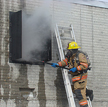
Live Experiments Examine Impact Of Changes In Firefighting Resources
Minutes after a two-story townhouse caught fire on February 5, engines and crews raced to the townhouse to extinguish the fire and search for victims. No one was injured, however, because this was one of many fire experiments performed this winter by researchers from the National Institute of Standards and Technology (NIST) and other organizations.
The tests with real fires and real firefighters are part of a landmark study examining the effect of firefighter crew sizes and equipment arrival times on fire growth rates and an occupant’s ability to survive a building fire.
One day these experiments may help cut the number of people injured or killed in fires, as well as reduce property damage, by helping governments make more informed decisions that match firefighting resources with risks to the public and firefighters in their communities.
Fire is a costly problem. According to the National Fire Protection Association, in 2007 there were 530,500 structure fires that killed 3,000 civilians and injured more than 15,000 while causing $10.6 billion in property damage. About 100 firefighters die in the United States each year -- 9/11 being the exception. Many more are injured.
The study focuses on the effects of crew size (two, three, four and five persons per fire engine) and apparatus arrival time (all engines/trucks arrive close together or arrive at longer intervals) on the fire conditions within one 2,000-square-foot two-story townhome specially built to survive the many fires required for these experiments. This “burn house” was instrumented with state-of-the-art equipment to monitor the interior temperatures and toxic gas buildup within the structure. In addition, researchers monitored 22 different firefighting tasks at the site.
Each day over the course of two weeks, about 50 firefighters from Montgomery County, Md., and nearby Fairfax County, Va., participated in the experiments held at the Montgomery County Fire & Rescue Training Center in Rockville, Md.
“Currently local governments rely on trial and error or a qualitative basis to allocate fire-fighting resources,” said NIST researcher Jason Averill. “When this study is complete, there will objective data on which to base these important decisions.” The study is due to be completed in Fall 2009.
The research is being conducted by a broad coalition in the firefighting community, including national labor and management organizations, and funded by the U.S. Department of Homeland Security, Federal Emergency Management Agency’s Assistance to Firefighters Grant Program. Researchers in NIST’s Building and Fire Research Laboratory planned these experiments with fire researchers from the International Association of Fire Fighters and Worcester Polytechnic Institute.
If the funding is continued, researchers plan to develop and validate a computer model that will allow local government decision makers to conduct “what if” analyses to help them make informed choices about managing resources for public and firefighter safety.